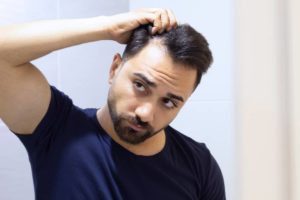Hair transplant surgery is a major decision in your life. Some patients are worried that the side effects of a surgical procedure on their scalp might outweigh the advantages of a permanent solution to hair loss.
All reputable hair transplant clinics should be straightforward with you about the potential risks of their operation. Here are some of the frequently asked questions about hair transplant risks.
FUT hair transplant procedures
With the FUT (Follicular Unit Transplantation) method, a narrow strip of skin is taken from the donor area, from which the follicular units (grafts) are then extracted. These individual hair follicles are then used to fill in the bald areas. The wound at the back of the head is sutured with a special technique so that a small scar remains, which can be covered by the hair.
If the treating doctor does not master this technique or does so inadequately, there is a risk that a bulging scar can develop at the back of the head, the donor area. In addition, infections and inflammations can occur due to the relatively large wound.
The chances of these problems are low, but are higher than newer methods such as FUE (Follicular Unit Extraction) or DHI (Direct Hair Implantation).
FUE and DHI hair transplant procedures
With the FUE (Follicular Unit Extraction) and DHI (Direct Hair Implantation) methods, the grafts are taken individually from the donor area.
The individual hair follicles are then inserted into the recipient area. The wound area – especially in the donor area – is much smaller, which minimises the risk of wound infection.
The FUE method requires very precise, accurate and concentrated work, especially when inserting the grafts into the recipient area. Here, of course, it is also important to achieve a result that is as natural as possible and to observe the direction of growth of the transplanted hairs.
Inexperienced doctors and their teams can have difficulties here. For example, the hairline may look unnatural and unattractive after the transplant.
Dr. Levent Acar from the Cosmedica Clinic in Istanbul has decades of experience in hair transplantation.
What are the risks after a hair transplant?
The procedure is performed under local anaesthetic and is minimally invasive. It is usually neaely completely painless.
After the procedure itself, you may feel some tension and/or numbness in the scalp. This should disappear after a few days.
It is also completely normal for the scalp to be swollen after a hair transplant. This is partly due to the local anaesthetic that is injected under the skin and partly due to the wound fluid that accumulates.
The incisions made during the hair transplant can also become infected. To avoid infections, work must be done under sterile conditions. When choosing a clinic for your hair transplant, make sure that the medical standards are impeccable.
Itching after the procedure is similar. Hair can grow inwards, especially with curly or frizzy types of hair, and the healing process can be a little uncomfortable. You can prevent infection by trying not to scratch the itchy areas.
You should expect that the transplanted hairs will fall out shortly after the hair transplantation. The hair follicles must regenerate after the hair transplantation, which can take up to three months. However, the hair will grow normally afterwards.
What can I do to minimise the risk?
Of course, as a patient you can do a lot to minimise the risks of a hair transplant.
Do not approach the procedure with false expectations: Even with a hair transplant, there are certain limits, for example, regarding the fullness of the hair. If you already had relatively thin hair before the procedure, you will not get a lion’s mane.
In a hair transplant, the hair is merely redistributed from the donor area to the recipient area to fill in bald spots. The more hair the surgeon can remove from this area, the better the result.
Dr. Levent Acar of Cosmedica Clinic and his team advise each client and patient thoroughly and also explain what is feasible and what is not.
Choosing a clinic
Whether you want to have the procedure done in the UK or abroad, like in Turkey, thorough research is necessary.
What are the reviews on Google, hair transplant forums, and the like, and are there any testimonials? What about the hygiene standards? The Cosmedica Clinic is JCI (Joint Commission International) certified – this is the gold standard in aesthetic medicine.
If you follow your doctor’s instructions exactly, there should be practically no negative side effects after a hair transplant. In the initial period after the procedure, you should take care of yourself and your scalp as much as possible to achieve an optimal result.
Contact Dr. Acar at Cosmedica Clinic and get a free, no commitment and personally-tailored hair consultation.




